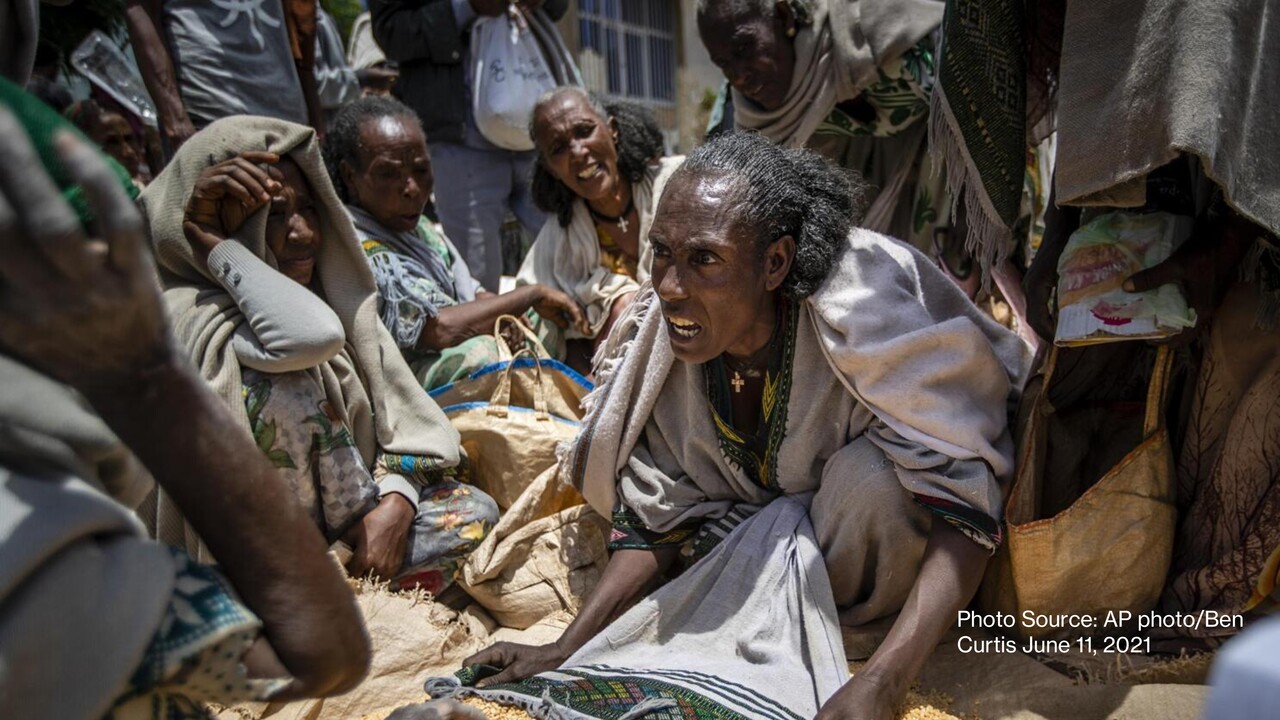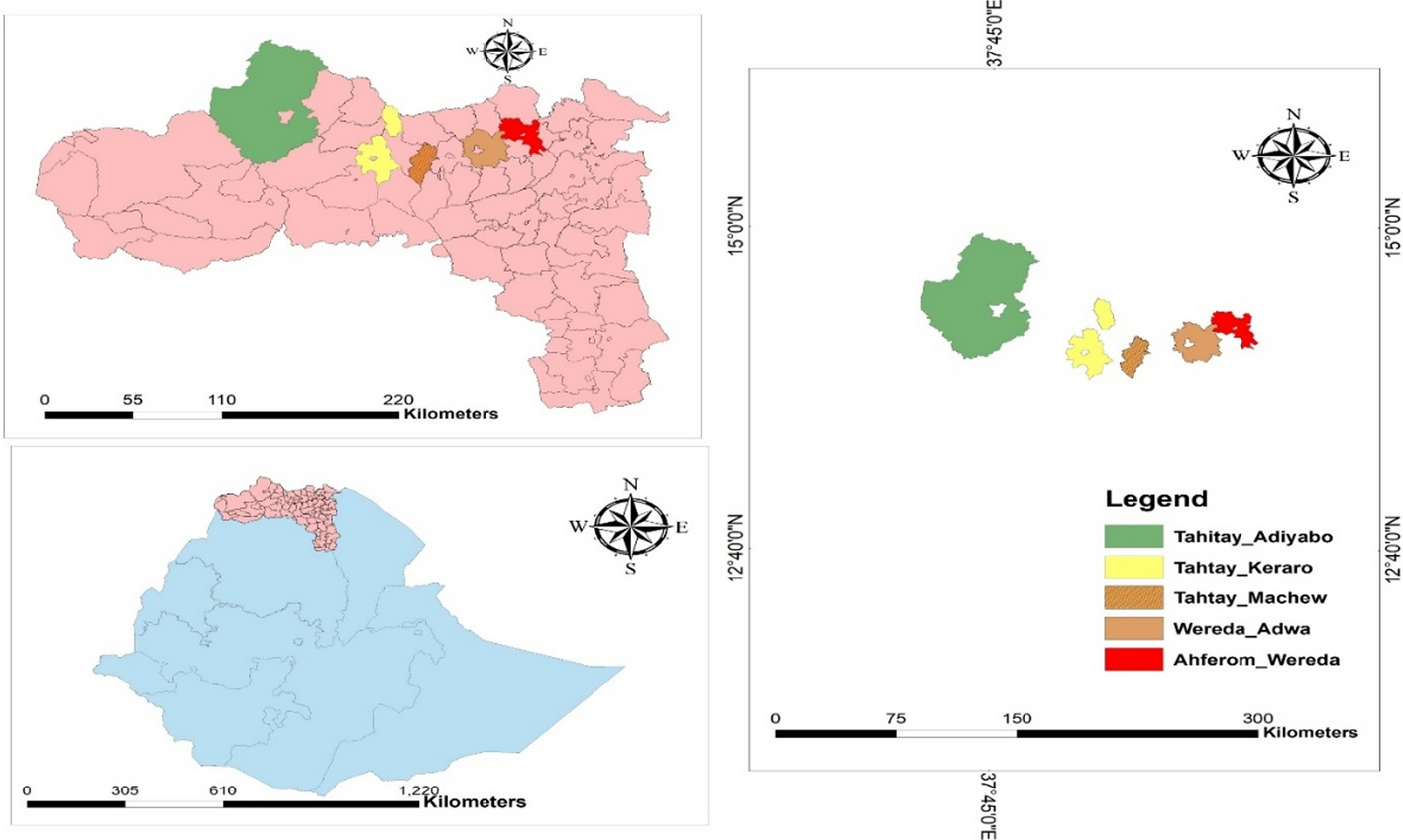Gender disparities in post-war food insecurity among urban households in Tigray, Ethiopia
Published in Sustainability and Law, Politics & International Studies

When the war in Tigray ended, we wanted to understand how families in towns and cities were managing their lives. Many previous studies had shown how conflict disrupts farming and rural livelihoods, but little was known about what happens to urban families. We grew up in Tigray and have seen that life in towns depends on markets and cash, not on farmland. When banks, roads, and markets were destroyed, people could not buy food even when some supplies were available. We wanted to know how this situation affected women, particularly those who became heads of households after losing husbands or relatives during the war.
Understanding the hidden hunger in cities
Our study focused on six urban centres in Tigray: Enticho, Adwa, Axum, Shire, Endaba-Guna, and Shiraro. These towns experienced some of the most severe destruction. Between May and June 2024, we gathered data from 740 households. The survey asked families about their food situation over the previous month. We wanted to understand whether households led by women were more likely to experience hunger and what factors contributed to that difference.
The findings were deeply concerning, although they were not unexpected. Nearly half of all families in urban Tigray were food insecure. Only 17% could be considered fully food secure. Female-headed households were 24% more likely to face hunger than those led by men. Many of these women had become widows or had been separated during the conflict. They had to care for several dependents with limited income opportunities. Education and humanitarian assistance helped reduce this gap slightly, but widespread destruction, the loss of income sources, and the heavy burden of household care made recovery extremely difficult.
Beyond income and education
When we analysed the data, we found that gender disparities were not only linked to income or education. About half of the difference came from structural and social barriers that numbers alone cannot describe. Many of these barriers were shaped by long-standing inequality and cultural norms. Some women explained that they often ate last after serving other family members. Others said they felt uncomfortable asking for help or had little control over decisions about aid distribution. Men still dominated most local committees that managed assistance. These findings reveal that food insecurity is not only an economic issue but also a social and gendered challenge.
Conducting research in a difficult environment
Carrying out research in post-war Tigray was extremely demanding. The conflict had left the region without electricity, transport, and reliable communication for many months. Even after the peace agreement, travel remained risky, and infrastructure was badly damaged. Enumerators often had to cross destroyed bridges and walk long distances to reach participants. Despite these hardships, communities received us with generosity and trust. Many people wanted to share their stories so that their experiences would not be forgotten. Their courage and resilience gave our team the motivation to complete the study.
What the findings show
The results demonstrate that conflict reshapes gender roles and responsibilities in complex ways. Women in urban areas carry a heavier burden of recovery because they are responsible for food, children, and the overall well-being of their households. When banks close and jobs disappear, women lose both their income and the informal support systems that once helped them manage. In cities where survival depends on cash rather than crops, this creates rapid and widespread hunger.
Households that received humanitarian aid were able to cope better with food shortages. This shows that fair and transparent aid distribution is not only a moral duty but also an essential part of sustainable recovery. However, the study also revealed that access to assistance was not always equal. Some women said that they had been excluded from aid because they were not registered, while others said that local leaders controlled distribution in ways that favoured men. These stories remind us that rebuilding fairness and trust is as important as rebuilding physical infrastructure.
The human face behind the numbers
While analysing the data, we were constantly reminded that each number represented a person. Behind every statistic is a woman trying to feed her children in a damaged city, or a family forced to choose between food and medicine. These stories are painful, but they also contain hope. Many women have already begun rebuilding their lives. Some have started small businesses, others have joined savings groups, and many have found new ways to support one another. Their determination shows that resilience and solidarity are at the heart of recovery.
Looking toward the future
The message of our study is clear. Post-war recovery must take gender into account at every stage. Rebuilding markets and infrastructure is essential, but rebuilding equality is equally important. Policies should focus on improving women’s access to employment, microfinance, and education. Humanitarian programmes must also ensure that women are included in aid decisions. Supporting women is not simply about fairness. It is the most effective way to rebuild families and communities.
This research contributes to a deeper understanding of how gender and conflict interact in urban settings. Hunger is not only about the absence of food. It is also about inequality, lack of opportunity, and limited access to power. The future of Tigray and other post-conflict regions will depend on how well recovery efforts can transform relief into resilience and resilience into equality.
About the author
Hafte Gebreselassie Gebrihet (PhD) is an Associate Professor at the Western Norway University of Applied Sciences. His work focuses on conflict recovery, gender equality, and food security in East Africa. He aims to use research to support fair and lasting recovery for communities affected by war. His broader interests include development, comparative politics, political economy, democratic governance, corruption systems, polarisation, food insecurity, conflict, and humanitarian crises.
Yibrah Hagos Gebresilassie (Ph.D.) is an Associate Professor of Economics at Aksum University, Tigray, Ethiopia. His academic expertise encompasses university teaching, applied research, and advanced quantitative data analysis, underpinned by a strong interdisciplinary focus. His research interests span health economics, poverty and inequality, impact evaluation, food security, development economics, and broader applied economic analysis.
Follow the Topic
-
Discover Food

This is a transdisciplinary, open access journal that provides a leading platform for the rapid dissemination of knowledge and advances covering the research and innovation that is taking place across the food sector.
Related Collections
With Collections, you can get published faster and increase your visibility.
Exploring the Role of Functional Foods in Addressing Modern Nutritional Gaps and Health Challenges
The increasing prevalence of chronic diseases, dietary insufficiencies, and lifestyle-related health challenges has intensified the global focus on functional foods. These foods, fortified with bioactive compounds, hold the potential to bridge the gap between nutrition and therapeutic intervention, addressing both preventative and remedial health concerns. This collection, "Exploring the Role of Functional Foods in Addressing Modern Nutritional Gaps and Health Challenges," aims to curate cutting-edge research that explores the development, efficacy, and societal impact of functional foods. We invite submissions that delve into the biochemical mechanisms, clinical outcomes, and technological innovations related to functional food production and consumption.
This Collection stands out by bridging the gap between functional food research and real-world applications for global health challenges. Unlike existing studies that focus on either biochemical mechanisms or clinical outcomes in isolation, our approach integrates multiple perspectives, including food technology, public health, sustainability, and consumer behavior. Additionally, the direct alignment with SDGs (2, 3, and 12) makes this collection unique in its scope and impact. SDG 2 (Zero Hunger) – Functional foods as a means to address micronutrient deficiencies and improve global nutrition. SDG 3 (Good Health and Well-being) – The role of functional foods in preventing and managing chronic diseases. SDG 12 (Responsible Consumption and Production) – Sustainable sourcing, production innovations, and food waste reduction in functional food development.
By fostering interdisciplinary dialogue, this collection aspires to advance the understanding and application of functional foods in mitigating modern nutritional challenges. To ensure a well-rounded collection, we propose the following key subtopics:
• Bioactive Compounds and Nutritional Enhancement: polyphenols, peptides, probiotics, and prebiotics in functional foods;
• Dietary Interventions and Health Benefits: functional foods for metabolic disorders, cardiovascular health, gut microbiota modulation;
• Technological Innovations in Functional Food Production: novel food processing methods, encapsulation, and bioavailability improvement;
• Regulatory and Consumer Aspects: regulatory challenges, labeling, consumer acceptance, and market trends;
• Functional Foods and Sustainable Development Goals (SDGs): Role in combating malnutrition, promoting sustainable agriculture, and reducing food waste;
• Public Health and Nutrition Sciences: Investigating the impact of functional foods on global health;
• Biochemistry and Food Science: Exploring the molecular mechanisms and bioavailability of bioactive compounds;
• Food Technology and Engineering: Innovative processing, preservation, and formulation techniques;
• Regulatory and Market Experts: Consumer acceptance, labeling policies, and commercialization pathways.
This Collection supports and amplifies research related to SDG 2, SDG 3 and SDG 12.
Keywords:
Functional foods; Bioactive compounds; Chronic disease prevention; Probiotics and prebiotics; Sustainable nutrition; Food technology innovations; Nutraceuticals; Regulatory challenges in functional foods; Consumer behavior and acceptance;
Publishing Model: Open Access
Deadline: Jan 31, 2026
Probiotics and Human Health: Current Innovation, Safety and Challenges
In recent years, there has been growing understanding and evidences about human health and its relationship to food. Although the battle against a number of illnesses continues likewise lactose intolerance, diarrhea, inflammatory bowel disease, irritable bowel syndrome, overweight and diabetes, cancer, colorectal cancer and coronary artery disease. Therefore, scientific communities are aiming to employ a cutting-edge dietary-based strategy such as probiotics to create a better human health and well-being. Since, such innovative dietary approaches not only offer nutritional benefits but it provide various health-giving properties. Over the last few years, probiotics have gained a lot of popularity due to the growing scientific evidences demonstrating their potential therapeutic benefits. The Food and Agriculture Organization has described probiotics as "live micro-organisms that, when given in sufficient amounts, confer a health benefit on the host." Many fermented foods contain live microorganisms that are genetically related to probiotic strains. Foods that have undergone fermentation using probiotic strains have shown to improve nutritional value and functional properties by converting substrates into bioactive and bioavailable end-products. Furthermore, probiotic supplementation in diet have also demonstrated a promising strategy against a variety of enteric pathogens because of their unique ability to either alienate pathogens or compete with the pathogenic microbiota for adhesion sites, or to stimulate, modulate, and regulate the host's immune response by triggering the activation of particular genes both inside and outside the host intestinal tract. Probiotics supplementation can be done by adding them to meals and beverages, whether they are dairy- or non-dairy-based. Furthermore, Probiotics' sensitivity to gastrointestinal stressors and processing conditions pose the biggest obstacle to their use in the food sector. In addition, there are several safety issues encountered during its administration. While at the same time, it is necessary to update, reform, and tighten the policies and regulations for the food manufacturers dealing with such functional foods to protect consumers from false and misleading claims.
Hence, various scientific evidence suggest that probiotics benefits in preserving and improving human health without or minimal negative effects. In addition, it will help in improving the overall health of gut microbiota leading to reduction in various chronic illness. Therefore, the current issue will focus on isolation, identification and characterization of probiotics strains, development of various probiotics or plant based probiotics, application of probiotics strains in various metabolic disorders as well as uncovering the potential of probiotics as a targeted therapy. It is hoped that prominent scientists working in this area will be able to contribute to novel findings and results within this field. In this topical collection, we welcome the submission of original research or review article with a focus on the following subjects as mentioned below (but not limited to):
• Current innovation and product developments for production of probiotics.
• Role of various probiotic strains and its effect for the maintenance of gut microbiota and human health.
• Role of probiotic as nutraceuticals and functional food for the management of different metabolic disorders.
• Uncovering the potential of probiotic as a targeted therapy.
• Mechanistic approaches to understand probiotics and its clinical application.
• Current advancements and technological innovations in the field of probiotic as functional food.
• Application of probiotics for the management of gastrointestinal disorders, diarrhea, diabetes, obesity, cancer, cardiovascular disease, improving immunity, neurodegenerative disorders and many more.
• Safety guideline, potential adverse effect and challenges associated for the development of probiotics.
• Probiotic supplementation and its clinical doses for better human health and well-being.
Keywords:
Probiotics; Functional food; Health effect; Bifidobacterium; Lactobacillus; Fermentation Cancer; Diabetes; metabolic disorders
Publishing Model: Open Access
Deadline: Dec 31, 2025




Please sign in or register for FREE
If you are a registered user on Research Communities by Springer Nature, please sign in